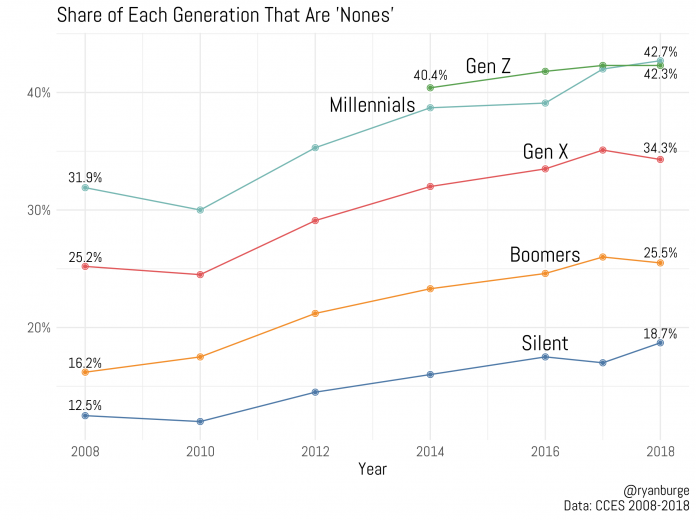By now, we’ve all heard about the rise of the “nones.” Every year there seems to be another round of survey data indicating that the religiously unaffiliated in the US have jumped another percentage point or two.
But some recent findings about Generation Z may challenge that narrative, suggesting that the share of the nones may be leveling off.
The oldest members of Gen Z were born in 1995, which means that they joined survey populations when they turned 18, starting in 2013.
It would be fair to assume that their level of religious unaffiliation should exceed that of the millennials before them, the same way millennials left religion in larger numbers than Generation X. But that assumption is not borne out by the data.
Although all age groups have increasingly stepped away from religion over the past decade, every generation except Gen Z showed significantly higher rates of disaffiliation than the ones before.
In 2008, boomers had 4 percent more nones than the Silent Generation, while Generation X was 9 percent higher than boomers. Millennials topped the charts at nearly a third of the population falling into the nones category.
That separation has persisted over the past decade. The rate of nones among the Silent Generation—the oldest subset—has increased by half, from 12.5 percent to 18.7 percent. By 2018, a quarter of boomers and a third of Gen Xers were unaffiliated. But the jump among millennials was truly unprecedented, climbing more than 10 percentage points in just 10 years to 42.7 percent.
Generation Z, during half the studied time, has appeared to chart a much different course. The rate of disaffiliation among Gen Z was just one percentage point higher than millennials in 2014. It moved up less than 2 percentage points in four years, meaning that the percentage of nones among Gen Z ended up no different than millennials: both around 42.5 percent.
Because Generation Z is still fairly young in these samples, it is possible many are still influenced by the religion of their parents. As a result, their disaffiliation may rise as they move into their late 20s and early 30s. Another possibility is that the nones have reached a natural ceiling at around 40 percent. However, that theory cannot be thoroughly tested until we have another decade of data.
All Content & Images are provided by the acknowledged source
